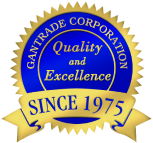
Pentaerythritol, commonly known in the Chemical Industry simply as “Penta,” is a white, odorless, crystalline powder. Pentaerythritol is soluble in water, slightly soluble in alcohol and insoluble in most hydrocarbons. Higher homologues of Penta, including Di- and Tripentaerythritol are also produced in the manufacturing process. Dipentaerythritol is an off-white powder that is less soluble than Pentaerythritol.
Gantrade Corporation is proud to partner with Hubei Yihua Chemical Industry Co. Ltd based in China as our strategic global supplier for Penta.
In this FAQ, we will discuss many aspects of Pentaerythritol, including chemistries, applications, packaging, and more.
Pentaerythritol is manufactured from formaldehyde and acetaldehyde in the presence of an alkaline catalyst, such as sodium or calcium hydroxide. Pentaerythrose is initially formed from three sequential aldol reactions and then subsequently reduced in a crossed Cannizarro reaction with formaldehyde to produce Pentaerythritol.
Pentaerythritol, with its chemical structure depicted below, is a five-carbon, with four reactive alcohol groups.
Alkyd Resins
Alkyds are used in paints and in moulds for casting. They are the dominant resin or "binder" in most commercial "oil-based" coatings. Approximately 200,000 tons of alkyd resins are produced each year.
Rosin and Tall Oil Esters
Rosin is an ingredient in printing inks, photocopying and laser printing paper, varnishes, adhesives (glues), soap, paper sizing, soda, soldering fluxes, and sealing wax. The tall oil rosin finds use as a component of adhesives, rubbers, and inks, and as an emulsifier.
Special Varnishes
Varnish is a transparent, hard, protective finish or film primarily used in wood finishing but also for other materials. Varnish is traditionally a combination of a drying oil, a resin, and a thinner or solvent.
Plasticizers
Plasticizers or dispersants are additives that increase the plasticity or fluidity of the material to which they are added; these include plastics, cement, concrete, wallboard, and clay.
Insecticides
An insecticide is a pesticide used against insects. They include ovicides and larvicides used against the eggs and larvae of insects respectively. Insecticides are used in agriculture, medicine, industry and the household. The use of insecticides is believed to be one of the major factors behind the increase in agricultural productivity in the 20th century
Synthetic Lubricants
Synthetic lubricants can be manufactured using chemically modified petroleum components rather than whole crude oil, but can also be synthesized from other raw materials. Synthetic lubricant is used as a substitute for lubricant refined from petroleum when operating in extremes of temperature, because it generally provides superior mechanical and chemical properties than those found in traditional mineral oils. Aircraft turbines, for example, require the use of synthetic oils, whereas aircraft piston engines don't.
Explosives
Explosive is a substance that contains a great amount of stored energy that can produce an explosion, a sudden expansion of the material after initiation, usually accompanied by the production of light, heat, sound, and pressure.
Antioxidants
An antioxidant is a molecule capable of inhibiting the oxidation of other molecules. Oxidation is a chemical reaction that transfers electrons from a substance to an oxidizing agent. Oxidation reactions can produce free radicals. In turn, these radicals can start chain reactions that damage cells. Antioxidants terminate these chain reactions by removing free radical intermediates, and inhibit other oxidation reactions.
Ink
Ink can be a complex medium, composed of solvents, pigments, dyes, resins, lubricants, solubilizers, surfactants, particulate matter, fluorescers, and other materials. Ink is a liquid that contains pigments and/or dyes and is used to colour a surface to produce an image, text, or design. Ink is used for drawing and/or writing with a pen, brush, or quill. Thicker inks, in paste form, are used extensively in letterpress and lithographic printing.
PVC Stabilizers
Polyvinyl chloride is the third most widely produced plastic, after polyethylene and polypropylene. PVC is widely used in construction because it is cheap, durable, and easy to assemble.
The stabilizers are barium, calcium and zinc salts of dicarboxylic acid esters of Penta, such as the zinc salt of pentaerythritol di-phthalic acid ester or di-terephthalic acid ester. The role is to solubilize the barium and zinc in the PVC so these salts can remove labile chloride groups on the PVC resin.
Paint Swelling Agents
Penta and its esters are used as ingredients in paint stripping formulations that also contains solvents, wetting agents, and swelling agents. The swelling agents help to separate the paint from substrate. The polyol portion of the Penta ester can also act as a redistribution compound via transesterification.
Radiation Curing Monomers
End-capping of isocyanate terminated polyurethane prepolymer with a monofunctional acrylate like pentaerythritol triacrylate renders the polyurethane radiation curable. Other UV-curable penta-based acrylates are pentaerythritol tetraacrylate and ethoxylated pentaerythritol tetraacrylate. Urethane acrylates have very good flexibility and very good adhesion. Acrylatyed dipentaerythritol exhibits increased crosslinking and high reactivity and offers very good hardness, scratch resistance and chemical resistance.
What are the sales specifications for Pentaerythritol available at Gantrade?
Pentaerythritol 98% Min
Mono-pentaerythritol 98%
Phthalic Colour (Gardner) 1 Maximum
Hydroxyl Content 49% Min
Melting Point 255ºC Min
Ash 0.05 wt % Max
Moisture 0.2% Max

